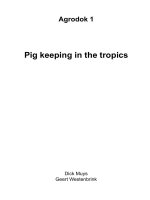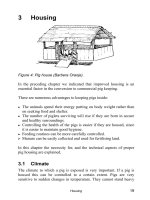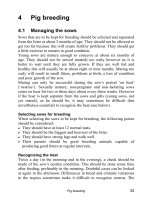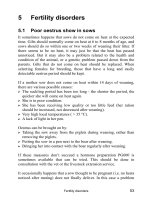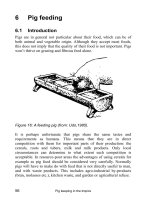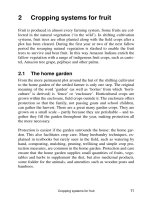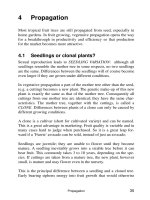Pig keeping in the tropics - part 3 pot
Bạn đang xem bản rút gọn của tài liệu. Xem và tải ngay bản đầy đủ của tài liệu tại đây (248.48 KB, 20 trang )
Pig breeding 33
4 Pig breeding
4.1 Managing the sows
Sows that are to be kept for breeding should be selected and separated
from the litter at about 3 months of age. They should not be allowed to
get too fat because this will create fertility problems. They should get
a little exercise to remain in good condition.
Young sows are mature enough to conceive at about six months of
age. They should not be served (mated) too early however as it is
better to wait until they are fully grown. If they are well fed and
healthy this will usually be at about eight or nine months. Mating too
early will result in small litters, problems at birth, a loss of condition
and poor growth of the sow.
Mating can only be successful during the sow’s period ‘on heat’
(‘oestrus’). Sexually mature, non-pregnant and non-lactating sows
come on heat for two or three days about every three weeks. However
if the boar is kept separate from the sows and gilts (young sows, not
yet mated), as he should be, it may sometimes be difficult (but
nevertheless essential) to recognise the heat (see below).
Selecting sows for breeding
When selecting the sows to be kept for breeding, the following points
should be considered:
? They should have at least 12 normal teats.
? They should be the biggest and heaviest of the litter.
? They should have strong legs and walk well.
? Their parents should be good breeding animals capable of
producing good litters at regular intervals.
Recognising the heat
Twice a day (in the morning and in the evening), a check should be
made of the sow’s oestrus condition. This should be done some time
after feeding, preferably in the morning. Doubtful cases can be looked
at again in the afternoon. Differences in breed and climatic variations
in the tropics sometimes make it difficult to recognise oestrus. The
Pig keeping in the tropics 34
first sign is a redness and swelling of the vulva, which is more obvious
in gilts than in sows. Another sign is that other sows in the pen start to
mount the sow on heat.
The clearest indication is the reaction of
the sow to the boar. If a boar is brought
alongside the sow’s pen, a sow on heat
will advance towards the boar. They
exhibit a typical ear display (especially
noticeable in breeds with erect ears). If the
sow does not react convincingly, then the
boar should be let into the pen. The boar
will nose the vulva and prod the sow in the
belly and flank. If the sow accepts he will
mount her. A good oestrus sow will stand
rigid when mounted, with her back legs
slightly apart (the so-called standing
reflex).
Even without a boar, the standing reflex
can be provoked in a good oestrus sow,
although it is less easy with gilts. You
should approach the sow quietly and prod
her gently in the flank with your fist. Then
press down gently with both hands on her
back. If the sow allows this you can try to
straddle the small of her back (see Figure 11). If the animal does not
move from her position she is almost certainly on heat.
Gilts coming on heat for their first time should not be served
immediately. They are still too young and their bodies are not yet
strong enough to carry and deliver a good litter. Gilts in good
condition can be served for the first time after they have come on heat
regularly a few times (keep records! see Paragraph 4.7). Let a young
boar who is not too heavy do the job as gilts are too small for a heavy
boar.
Figure 11: The standing
reflex
Pig breeding 35
Timing the service
In normal circumstances healthy sows and sufficiently mature gilts
should be mated regularly (food supply and sows’ condition
permitting). Once a sow has farrowed she will not usually come on
heat for some time (whilst she is still feeding the piglets). Most sows
come on heat again in the week after weaning their litter. When they
finally do, they are very fertile and should be served. They are full of
energy and will conceive easily. The second heat is not as strong and
the instinct to conceive will have decreased a lot. At the third heat a
sow may not conceive at all and you might be left with a pig only
good for slaughter. On top of that, if a heat passes without service, the
animal has to be fed for a further three weeks until the next heat,
without being productive.
Sows should not be served by the boar at the very beginning of their
period on heat, nor at the end; this will result in small litters. There is
an optimum period during the three-day heat for service. On intensive
holdings, a sow is usually served 12 to 24 hours after the standing
reflex has been provoked (without the boar). The standing reflex
occurs when she is at the most fertile moment of her heat and it
indicates the moment when she is most willing to accept the boar. One
should always make sure that it is the first standing reflex of the heat,
and this is only possible by regular thorough checking.
In very hot conditions especially the period of fertility is shorter and
less obvious. If there is any doubt about the best moment, or if the
heat was only detected after introducing the boar, it would be better to
mate them twice after noticing the oestrus - preferably at the end of
the first day and at the beginning of the second. If the heat is really
doubtful then it would be better to postpone mating until the next heat.
Mating can take quite a long time, varying between 5 to 20 minutes.
The animals should not be disturbed during the operation, but it is
advisable to keep an eye on them. Heavy boars should not be used on
lighter sows. Often a young boar is kept for the gilts and an older boar
for the heavier sows.
Pig keeping in the tropics 36
Three weeks after mating, the oestrus should be extra carefully
checked. If there is no sign of it then the sow is usually in-pig
(pregnant).
Feeding
In the weeks before mating gilts and sows should be well fed (protein-
rich feed), as they must be fit and strong for mating. With good
feeding the chances of producing a large litter increase.
In reality a sow feeding a litter is already being fed a protein-rich
ration (see Paragraphs 6.5 and 6.6) and this should be continued until
she has been served. After mating the ration can be reduced to the
normal protein requirement (13 % - see Paragraph 6.5).
Later, in the final few weeks after pregnancy, she will need protein-
rich food again, because the next litter of piglets will be developing
fast inside her.
4.2 Selecting and working the boar
Selecting the boar
Selecting a boar is even more important than choosing your breeding
sows. In choosing a breeding boar, the same factors should be taken
into account as for the sows; this includes the presence of 12 nipples.
Avoid choosing a boar too highly in-bred from your existing stock, as
in-breeding will lead to reduced fertility, poor growth, and lower
levels of disease resistance.
Managing the boar
Young, healthy and well-developed boars should be mated for the first
time when they are 8 to 10 months old. Their first sow should be of
their own size or smaller. In the early stages the young boar should not
serve more than 1 sow per week. The number of services can
gradually be increased as indicated in table 1. If a boar mates more
often than this, his health and productivity will suffer.
Pig breeding 37
In hotter climates a single boar will suffice to serve between 5 and a
maximum of 25 sows. It is nevertheless advisable to keep at least 2
boars, an older heavier boar for the bigger sows and a younger lighter
one for the gilts. A boar should function well until about 5 to 6 years
old. Once he gets older than this the younger boar should take his
place and a new young boar be selected, or brought in, for the young
sows.
Table 1: Number of services of a boar in relation to its age.
Age of the boar Services
8 - 10 months Once per week At this stage you should check that the boar serves
properly and that the sows served by him are
succesfully inseminated.
18 months Max. 3 times per
week
24 months or
older
4 - 5 times per
week
Boars need rest periods. There shpuld be no more
than 15 services per month. Older boars can
occasionally be allowed to mate twice a day, but
never more than 6 times a week, with a maximum
of 20 times a month.
It is important to record the boar’s activity and the results obtained, so
that his performance can be assessed. The fertility of the boar is
indicated by the size of the litters he produces and the percentage of
sows in-pig after a first service (insemination rate). The information to
record is:
? the date of the service;
? the identification (name or number) of the sow he has served;
? the date of farrowing (which will tell you if the sow was
inseminated at the first service);
? the size of the litter.
In this way the performance of the boar can be compared with other
boars and on the basis of this decisions about keeping or replacing him
can be made. It is important to remember however that the quality of
the sows also has an influence on litter size and insemination rates.
Pig keeping in the tropics 38
Feeding and housing the boar
Boars should be kept neither too lean nor too fat. They need plenty of
exercise. In very hot conditions or when suffering from fever, they can
remain infertile for a long time. A boar that is ill should be rested for 1
to 2 months and be replaced by another for this period.
Boars should be housed in individual pens, for if they are kept with
non-pregnant sows it becomes impossible to tell whether and when he
has served the sows, and whether or not they are in-pig. It is therefore
important to separate the boar from them.
4.3 The birth and care of the new-born piglets
On average delivery will take place 115 days after conception (3
months, 3 weeks and 3 days). The sow will usually farrow during the
night or evening. In the last 14 days of pregnancy the udder will
increase in size. It feels firmer, and the nipples stand out more towards
the end of the pregnancy. In gilts the udder begins to develop after two
months of pregnancy.
Preparation measures
About a week before the expected delivery date the sow should be put
in a pen of her own, which should be disinfected first. Before going
into the pen, she should be wormed and treated for lice and mange.
She should be washed with soap and lukewarm water and then rinsed
with a mild disinfectant. If there is any risk of disease for the new-
born piglets the sow and the pen should again be washed and
disinfected 2 days before farrowing.
If you are not using a farrowing crate the sow should have plenty of
straw and litter to make a nest for the piglets. If she is in a crate you
should make a nest of fine bedding material for them.
In (semi-)intensive units she should also be given plenty of litter.
Avoid using very fine litter however, because the sow likes to chew
her litter into small pieces, and if she is frustrated in this she will start
to gnaw at the pen.
Pig breeding 39
On the day of farrowing the sow should not be given her normal food
but only laxative food (green fodder, for example) to ward off
constipation (see Paragraph 4.4)
Birth
About a day before the birth of the first piglet, the udder will start to
look much redder. A white or clear fluid can now be extracted from
some of the teats. The sow will be more lively, alert, restless and she
may start to bite. She scrapes the floor with her forefeet and sweeps
the straw bedding into a corner with her snout to make a nest.
Just before delivery, the udder will swell and the sow will calm down.
The birth of the first piglet is preceded by a bloodstained fluid oozing
from her vagina. In gilts the fluid may be released earlier. During the
birth the piglets are still enclosed in a membrane which will usually
break open as they are born. Piglets are born in the head-and-tail
position. On average a piglet will appear every 15 to 20 minutes, but
particularly small piglets may be born in very quick succession. Many
piglets are born still attached to the umbilical cord. This can be left, as
it usually soon breaks off on its own.
Figure 12: The sow and the new-born piglets (Barbera Oranje).
The sow may expel some of the afterbirth in between delivering each
piglet, but the afterbirth is usually expelled all at once, 30 minutes or
Pig keeping in the tropics 40
an hour after the birth of the last piglet. The sow may suck blood from
the afterbirth to build up her strength.
Piglets that are born premature (at 110 days or earlier) have
parchment-like skin, which is often very red with no hair or only very
short bristles. They may have misshapen claws, screwed-up eyes and
difficulty in breathing. They stray through the pen trying to find the
udder. Most of them will not survive. Normally about one pig in 20 is
still-born. Older sows have a higher percentage of still-born piglets.
Although there are normally very few complications at birth it is
advisable to be at hand, problems which can occur during the birth are
treated in Paragraph 4.4.
Care of the new born piglets
A few minutes after the birth the umbilical cord may be pulled gently
away or cut if necessary (to about 5 cm length). After the birth the
navel of each piglet should be soaked in a cup of iodine solution to
prevent inflammation and tetanus.
Each piglet should be rubbed carefully dry with a cloth and put onto
the udder. Their groping and sucking will encourage the sow to farrow
and to let down her milk, and it is important that the piglets
immediately take advantage of the valuable colostrum that will protect
them in the coming weeks against diseases (see Paragraph 4.5).
Piglets that have difficulty in breathing (weak irregular breathing) or
that appear to have died can be helped by holding their hind legs up in
the air. By pressing their chest (thorax) rhythmically their breathing
can be stimulated. Pouring a little cold water over their head and chest
can help, but the piglet should be dried off immediately afterwards.
In some cases, it may be necessary to trim the piglets’ teeth to prevent
them biting the udder. More information about this is given in
Paragraph 4.6.
If the sow does not produce enough milk the piglets should be
transferred to another sow if this is possible; otherwise they will have
to be given extra food by hand (see Paragraph 4.5).
Pig breeding 41
Anaemia
Young piglets kept on concrete floors may quickly develop serious
anaemia (a shortage of iron in the blood), because the sow’s milk does
not contain enough iron to cover the piglets’ needs. After two or three
weeks they become pale and their rate of growth drops. They may
develop a fat neck.
Anaemia can be prevented from birth by putting a shovel of ‘clean’
iron-rich soil or compost into a corner of the pen every day. Clean soil
is soil which has not been in contact with other pigs, so that there is no
danger of worm contamination. The piglets can rummage around in it
and take up some of the iron in the soil. Most of the red, brown and
yellow soils in the tropics contain adequate iron. Piglets (0 - 3 days
old) may be injected with an iron preparation, if available. Wood ash
can also be put into the pen. This will not provide iron, but it does
contain other important minerals.
4.4 Problems related to the birth
Although there are normally very few complications at birth it is
advisable to be at hand. If the whole process of delivery takes longer
than 8 to 12 hours then there is something wrong. In particular the last
piglets may be born in the membrane and will suffocate if they are not
taken out. It is also true that sows do not pay much attention to their
offspring until all the litter has been delivered. Piglets that waste no
time in searching for milk may easily be crushed if the sow lies down
again in the course of the farrowing. By being on hand to intervene in
time this can be prevented.
A sow will not always accept human company whilst she is farrowing.
Remain at a discreet distance and be ready to intervene if it appears
really necessary.
Slow Delivery
If the sow does not seem to be making any headway and delivery
seems to be taking a long time, the first piglet may have to be helped
Pig keeping in the tropics 42
out by hand. For this the utmost hygiene is essential:- the sow’s rear
end should be thoroughly cleaned and even disinfected, as should the
operator’s hands. Grease the hand and the vagina with vegetable oil or
Vaseline (avoid soap) and work the hand slowly into the vagina with a
slight rotary movement. Simply by doing this it is possible that the
sow will start her contractions and push the piglet out.
If this does not work the sow can be injected with 2 cc of oxytocin
(not more), which is available on the market under different names. If
this has no effect after an hour the piglet will have to be released
manually, preferably by someone with a small hand which is clean and
well lubricated. If still no progress is made another injection may be
given.
If the piglet is really too big a caesarean operation is the only solution.
If there is no vet at hand this may not be possible and the sow will
have to be slaughtered. It is obviously preferable to try to prepare for
such eventualities in advance.
Accidental killing of the piglets by the sow
It is quite normal for sows to eat the afterbirth and any still-born
piglets. Some sows, especially young gilts, can be aggressive towards
their litters. The reason for this is not clear. During farrowing an
inexperienced mother may become frightened by the new-born
piglets; she may try to avoid them and start biting. If this happens the
piglets should be put in a box and kept warm (possibly with a heating
lamp). The mother will usually quieten down. If she doesn’t she could
be given some beer (1 or 2 bottles) after farrowing. If it is available a
tranquilliser (or sedative) such as ‘Stresnil’ (2 mg/kg) can be injected.
Some people maintain that it is by eating the afterbirth that the mother
is encouraged to start on her piglets too.
The sow becomes ill after farrowing
The most common disorder affecting sows after farrowing is an
inflammation of the uterus (metritis) or of the udder (mastitis).
Pig breeding 43
Sometimes they are found in combination. The sow appears dazed,
refuses to get up and to eat, and is feverish.
? metritis
This is recognisable by a whitish-yellow and/or ill-smelling
discharge from the vagina (although a small amount of reddish
mucus is normal for a few days after the birth - it is not always very
significant). At any sign of a bloodstained, ill-smelling liquid
exuding from the vagina checks should be made to see if there are
any piglets remaining inside. If so they must be released as
described in the paragraph above on ‘Slow delivery’.
? mastitis
In this case one or more of the udders may become hard and
swollen, turning red to reddish-blue in colour. This usually starts at
the back of the udder. Milk production drops rapidly and the piglets
become hungry, starting to squeak and screech.
If the sow has a temperature of over 39.5 °C. she should be treated
at once. As soon as possible she should be given a 5 cc injection of
oxytocin (always read the label first) and an antibiotic
(penicillin/streptomycin, (oxy)tetracyclin or chloramphenicol). If
after 24 hours this treatment has no effect the treatment should be
reviewed.
? constipation
It is normal for sows to stop eating shortly before farrowing. This
can however bring on constipation and a constipated sow may
become restless and neglect her new-born piglets.
Constipation can be eased by laxative foods (leafy greens , fruits
etc.). Oil or lard can also be mixed with the food. If it persists castor
oil (wonder oil) or Epsom salts can be given. The salts should be
dissolved in a small quantity of water.
In order to prevent constipation before farrowing, one or two
tablespoons of Epsom salts should be mixed with the feed each day
and extra leafy green foods should be given.
Pig keeping in the tropics 44
The hungry piglets should be kept warm (lamp) and given
additional feed of goat or cow’s milk, or a sweetened bean meal
porridge. In extreme cases the piglets should be put on another sow
or artificially reared (see para. 4.5 below).
4.5 Rearing motherless piglets by hand
If a sow dies shortly after farrowing the piglets will have to be reared
by hand, or by another sow. Rearing piglets by hand is very time-
consuming and often unsuccessful. It is far more effective to put the
piglets on another sow that has recently farrowed (less than 3 days).
This is usually more successful. Similarly, if a particular sow does not
produce enough milk for her litter, some of her piglets can be
transferred to another sow. If this does not work, or if you have no
sow available, the piglets will have to be reared by hand.
Put the piglets into a clean preferably straw-filled pen and keep them
warm. If possible hang a heat lamp in the pen at night and a
thermometer. The ideal temperature at first is 30°C (day and night)
coming down to 25°C after a fortnight. Throw some soil in a corner of
the pen to prevent the animals from becoming anaemic.
Feeding orphan piglets
It is essential that newly-born piglets receive colostrum straight after
the birth to build up their natural resistance. Colostrum is the first milk
that the sow produces after farrowing. If the sow dies whilst
farrowing, the colostrum will have to be taken from another farrowing
sow for the piglets. If they get no colostrum their chance of survival is
very small.
Cow’s or goat’s milk can be given, perhaps sweetened with sugar or
syrup, to piglets who have managed to obtain colostrum. The milk
should not be diluted, as sow’s milk is very concentrated. It should be
warmed up to slightly above body temperature (37° - 40°C) in a pan
lowered into a larger pan containing boiling water (bain-marie).
Pig breeding 45
If a sow dies whilst farrowing her piglets will not have learnt to drink.
The milk should be fed on a little spoon or in a feeding bottle. You
will have to make sure they take it in.
Later the piglets can be taught to drink from a shallow trough by
gently holding the snout in the milk. After every feed the bowl must
be thoroughly cleaned, dried, and occasionally disinfected. To avoid
indigestion the piglets should not be given too much at one time.
In order to encourage them to drink by themselves, boiled lukewarm
water (about twice the quantity of a milk feed) should be put in the
pen after the last feed of the day.
The feeding programme
For the first two days the piglets should be fed at regular intervals 5
times a day, for about 10 minutes each time. On the third and on the
fourth day they should be fed four times a day, and after that 3 times a
day. After 14 days, increase the quantity of milk at each feed, but
gradually decrease the number of feeds per day. Gradually change
over to more solid feed, so that by the age of about three weeks they
should be able to take regular feed. If no nutritious feed is available
they should continue on milk for a while longer. The weaker brothers /
sisters can be fed four times a day for a longer time. Table 2 serves as
a guide.
The figures in the table are maximum quantities - it is better to give
too little rather than too much feed. There should be a continuous
supply of water available, which should be boiled to avoid any
contamination.
Table 2: Feeding programme for orphan piglets.
Day Number of feeds Quantity each time (ml)
1 5 30
2 5 40-45
3 4 60
4 4 70
5-7 3 80-100
8-9 3 120
10-11 3 140
12-14 3 160
Pig keeping in the tropics 46
As soon as possible the orphan piglets should move onto regular food.
This should be of good quality, protein-rich, and easily digestible. It
should be remembered that, despite the amount of care they receive,
hand-reared piglets will never grow as fast as those reared by a mother
sow.
4.6 Looking after and weaning piglets
Teeth trimming
If the piglets prove turbulent
or aggressive, their tusk teeth
should be trimmed. This will
stop them fighting for the
teats and aggravating the sow
by biting them. Only the
points of the teeth should be
removed. If any more is
removed there is a risk of
damaging the mouth. In
commercial units the points
are filed off (Figure 13).
Castration
Male piglets are castrated to
prevent their meat from
smelling strongly, and also to
make sure that they are
manageable when they become sexually mature. Castration should be
done in the first two weeks of a piglet’s life. The animals should be fit
and healthy and if this is not the case it is better to postpone the
operation.
To carry out the castration two people are needed, the person carrying
out the small operation and an assistant to hold the piglet. The pen
should be dry and very clean. The assistant takes the pig by the hind
legs and holds it firmly between his/her legs, the piglet’s head pointing
Figure 13: Trimming the piglets’
teeth.
Pig breeding 47
Figure 14: Castration of a young boar (after Eusebio, 1980).
Pig keeping in the tropics 48
towards the ground. The other person has a very sharp knife that has
been thoroughly cleaned with a disinfectant (Figure 14 shows the
steps to follow).
Afterwards the wound should be washed thoroughly with a
disinfectant.
The other testicle is treated in the same way.
Weaning the piglets
Piglets should be weaned when they are about 8 weeks old. It is best
to take the sow away from the piglets, rather than leaving her in the
pen and removing the piglets. This is because piglets should not be
perturbed by the loss of their familiar nest, and because the sow will
come on heat again quicker. In the last few weeks the piglets should
already have started getting used to eating from a trough alongside
their mother, and now they should just continue doing so. They will
need protein-rich feed as they will be growing fast (see Chapter 6).
At the age of 3 months new breeding sows or boars can be selected
(see Paragraphs 4.1 and 4.2).
4.7 Record-keeping
For those who intend to keep a number pigs for breeding purposes it is
essential to have a good system of record-keeping. This will help to
keep track of developments, make comparisons and take decisions on
the management of the herd. It will also have a direct positive impact
on daily management.
Good record-keeping means noting down simply and clearly all
important details and events. It can also be used to provide and record
information for future activities - it is important for example to
calculate and note the next date for checking whether a sow is on heat
or the date when she should farrow. Such information should be
marked on a calendar, so that any necessary preparation can start well
in advance (for example preparing the farrowing pen for the sow).
Pig breeding 49
A good system of record-keeping requires little more than a notebook
or exercise book and, using a few pages for each sow, noting down all
the important events.
Relevant information to record would be for example:
? In the case of a breeding sow:
• The name of the sow
• The month and year of her birth
• Her parents’ names
? Important events:
• Date of her first heat
• Date of 2nd heat
• Date of 3rd heat
• Date of mating, and name of the boar
• Result of the heat check 3 weeks after mating (did she come on
heat again?)
If there are no signs of heat she must be in-pig, and the date of
farrowing can be established (115 days after mating).
If she has come back on heat she will now have to be put to the
boar again - Calculate the date when she might come back on
heat (3 weeks after mating).
• Anticipated date of farrowing – mark this one in a calendar!
• The date for putting the sow in a farrowing pen (1 or 2 weeks
before farrowing). Mark this in the calendar too!
• Actual date of farrowing
• Size of the litter, number of healthy piglets , and number of still-
born piglets
• Number of piglets that have survived and have been successfully
weaned (this gives an idea of the sow’s mothering qualities)
? Other information to note:
• Dates of illness, nature of the problem and the treatment or
medicines administered.
• Information on the piglets, e.g. vaccination information.
Pig keeping in the tropics 50
• If a piglet is selected for further breeding, such information
should be transferred to the new page of records opened for that
piglet in its new role as a breeding sow or boar.
Here is an example of a typical set of records:
Sow: Marianne. Date of birth: April 1996
Parents: Sow Suzy and Boar Patrick
15th October 1996 first heat
7th November 2nd heat
29th November 3rd heat
30th Nov. served by boar Hannibal
21st December Check for heat. No signs (–), she is therefore in-pig
Birth date can be established, that is 115 days after
mating
25th March 1997 Expected farrowing, written in calendar
15th March Separate Marianne from the others
18th March Marianne has been wormed and washed
26th March Farrowed: a litter of 4 boars and 3 sows, 1 piglet
still-born (dead)
21st May Weaning of the litter: 3 boars and 3 sows (one of
the boars has died)
Paragraph 4.2 has suggested which records should be kept to monitor
the boar’s activities.
Using Table 3 the date of farrowing can be worked out, if the date of
successful mating is known (date of mating + 114 days).
Marking the pigs
Being able to identify the pigs is essential if records are to be kept and
management activities planned. As long as you don’t have large
numbers of pigs there is no problem recognising them and no need to
worry about marking them. However when there are so many pigs that
they become difficult to distinguish it is time to introduce an
identification system. Giving your animals names also helps, and it is
easier to discuss them. They might even respond when you call them!
Pig breeding 51
Table 3: Farrowing table.
Date of mating Expected farrowing
date
Date of mating Expected farrowing
date
Jan 1 Apr 26 Jul 5 Oct 28
Jan 6 May 1 Jul 10 Nov 2
Jan 11 May 6 Jul 15 Nov 7
Jan 16 May 11 Jul 20 Nov 12
Jan 21 May 16 Jul 25 Nov 17
Jan 26 May 21 Jul 30 Nov 22
Jan 31 May 26
Feb 5 May 31 Aug 4 Nov 27
Feb 10 Jun 5 Aug 9 Dec 2
Feb 15 Jun 10 Aug 14 Dec 7
Feb 20 Jun 15 Aug 19 Dec 12
Feb 25 Jun 20 Aug 24 Dec 17
Aug 29 Dec 22
Mar 2 Jun 25 Sep 3 Dec 27
Mar 7 Jun 30 Sep 8 Jan 1
Mar 12 Jul 5 Sep 13 Jan 6
Mar 17 Jul 10 Sep 18 Jan 11
Mar 22 Jul 15 Sep 23 Jan 16
Mar 27 Jul 20 Sep 28 Jan 21
Apr 1 Jul 25 Oct 3 Jan 26
Apr 6 Jul 30 Oct 8 Jan 31
Apr 11 Aug 4 Oct 13 Feb 5
Apr 16 Aug 9 Oct 18 Feb 10
Apr 21 Aug 14 Oct 23 Feb 15
Apr 26 Aug 19 Oct 28 Feb 20
May 1 Aug 24 Nov 2 feb 25
May 6 Aug 29 Nov 7 Mar 2
May 11 Sep 3 Nov 12 Mar 7
May 16 Sep 8 Nov 17 Mar 12
May 21 Sep 13 Nov 22 Mar 17
May 26 Sep 18 Nov 27 Mar 22
May 31 Sep 23
Jun 5 Sep 28 Dec 2 Mar 27
Jun 10 Oct 3 Dec 7 Apr 1
Jun 15 Oct 8 Dec 12 Apr 6
Jun 20 Oct 13 Dec 17 Apr 11
Jun 25 Oct 18 Dec 22 Apr 26
Jun 30 Oct 23 Dec 27 Apr 21
Dec 31 Apr 26
Pig keeping in the tropics 52
There are various methods of physically marking animals, but in this
Agrodok we will only consider notching. We will not discuss
eartagging because the use of eartags requires special equipment
which is not easily available. All the animals should be marked when
they are young.
? Notching
Notching involves cutting small pieces of skin out of the edges of
the ears. By varying the pattern of the cuts you can individualise the
animals for identification. This is a very cheap method requiring
only a very sharp knife (disinfected, of course!). The disadvantages
of the method are that it takes time ‘to read’ the patterns (or codes),
and that problems can arise if the ears are damaged.
In Figure 15 an example of notching is shown. In this figure the
codes used on large farms are shown. A value is assigned to each
notch on each side of the ear. By adding up the values marked on
the ear the sow’s number can be known. You can of course
devise your own system of codes adapted to your particular
circumstances.
Figure 15: Notching and its codes (after Holnes, 1991).

